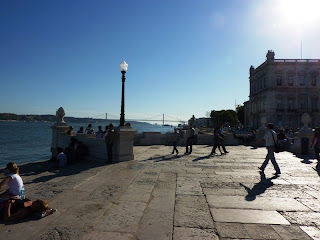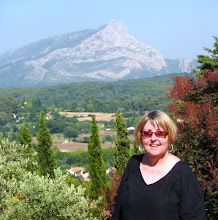On Thursday, June 2nd, our 2nd day in Lisbon, we were rested and ready to hit the streets. We walked all the way downtown by following our noses. We started at the little Rua dos Remedios of bollard and cleaning fame in my first post. It was an easy walk because it was literally all down hill.
The first order of business was to cross the Commercio Square and find the tourist information office. There we bought passes for all the forms of transportation, entry into museums, etc.
En route to the tourist office, I spotted the restaurant I wanted to visit for lunch. It is the Cafe Restaurante Martinho da Arcada. Although some dispute it, it is supposed to be the oldest restaurant in town, dating back to 1782 in its present form. According to its website (the English version doesn't seem to work), it actually started in 1778 as a tavern.
The Baixa or downtown center of Lisbon is "new". It was rebuilt after an earthquake in 1755. The Alfama, the largely Moorish area where we stayed, is much older and was not heavily damaged by the earthquake.
 The inside is beautiful and formal, although you can stop here and purchase some pastries to go.
The inside is beautiful and formal, although you can stop here and purchase some pastries to go. We chose to sit outside under the arcade to have lunch. We always seem to be in places at odd hours, so when we sat down, it looked a lot like this, but by the time we left, more people were stopping for coffee and cake.
We chose to sit outside under the arcade to have lunch. We always seem to be in places at odd hours, so when we sat down, it looked a lot like this, but by the time we left, more people were stopping for coffee and cake. Trout had a chef's salad and I had a tuna salad. His salad was great, but about what you would expect. Much to my surprise, my tuna was served over black-eyed peas with onions, tomatoes and celery, along with some other good stuff. The Portuguese were explorers and navigators, and their food is heavily influenced by where they went. I don't know if the black-eyed peas made their way to Portugal because of that or if they came with the Moors, but I was glad to see and eat them. They were cooked perfectly and yes, it was a cold salad.
Trout had a chef's salad and I had a tuna salad. His salad was great, but about what you would expect. Much to my surprise, my tuna was served over black-eyed peas with onions, tomatoes and celery, along with some other good stuff. The Portuguese were explorers and navigators, and their food is heavily influenced by where they went. I don't know if the black-eyed peas made their way to Portugal because of that or if they came with the Moors, but I was glad to see and eat them. They were cooked perfectly and yes, it was a cold salad.Since Lisbon is known as THE place for coffee and dessert, we had to have some. Trout got an ice cream thing, but I chose the Alentejano coffee cake. It was made with pumpkin and it was absolutely delicious. For me it was the best dessert of the whole trip. Alentejo is an area south of the Tagus River and stretching to the Algarve. It is famous for its cooking.
I do need to mention that Trout noticed someone dealing drugs right by where we were eating which was less than a block from the police station. Portugal decriminalized the personal use and possession of all drugs and started emphasizing treatment over punishement in 2001. Reports since then have indicated that the change in policy has been a big success. For more on that, take a look at the Economist article from 2009.
Now back to our walk. This is where the Commercio Square opens onto the Tagus. It reminds me of Venice.
 This is looking back from there to the square.
This is looking back from there to the square. Many people visit this place to rest for awhile and look at the river.
Many people visit this place to rest for awhile and look at the river. The square is big. Note the hill rising behind it.
The square is big. Note the hill rising behind it. The river is picturesque.
The river is picturesque. It was hard for me to decide where to look and snap.
It was hard for me to decide where to look and snap. Trout helped with the decision.
Trout helped with the decision. This is King Jose I (1714-1777). He was the king when the earthquake happened.
This is King Jose I (1714-1777). He was the king when the earthquake happened. This is the primary shopping street down town. Note the tiled street and the beggar to the left.
This is the primary shopping street down town. Note the tiled street and the beggar to the left. This is looking back at the clock in the arched entry to the shopping area. As per usual, we were there late in the day.
This is looking back at the clock in the arched entry to the shopping area. As per usual, we were there late in the day. Here's Trout walking along the patterned "sidewalk" area. No cars were allowed, but these side designs seem to mark a path for people to stroll and window shop.
Here's Trout walking along the patterned "sidewalk" area. No cars were allowed, but these side designs seem to mark a path for people to stroll and window shop. The center was more for moving faster or hanging out and for street entertainers.
The center was more for moving faster or hanging out and for street entertainers.
 We rarely see women doing this, but here is one.
We rarely see women doing this, but here is one. According to his sign, this guy is in the Guiness Book of World Records. I didn't try to verify that. He must have some kind of apparatus that comes from the cane and goes around him to hold him up.
According to his sign, this guy is in the Guiness Book of World Records. I didn't try to verify that. He must have some kind of apparatus that comes from the cane and goes around him to hold him up. He also paints his eyelids so he can keep his eyes closed. Could he be napping?
He also paints his eyelids so he can keep his eyes closed. Could he be napping? Standing around an attraction like him is a good place to get your pocket picked if you aren't careful. Lisbon was the only place where we saw evidence of that this trip.
Standing around an attraction like him is a good place to get your pocket picked if you aren't careful. Lisbon was the only place where we saw evidence of that this trip. As we were walking along, I was ahead of Trout taking pictures. I saw a young kid coming toward me pass something that looked like a wallet to a guy in front of me heading in my direction. I dropped back and pointed them out to Trout. Later he saw the two of them talking together, but in the initial pass, they only brushed up against each other.
Men in particular seem to hate wearing a money belt, but if you carry a typical wallet in any of the normal pants locations, you are likely to get it lifted in many places in the world. Lisbon is no exception.
One of the sites of Lisbon is the Santa Justa Elevator. Remember those hills? This is a way to get up to the top without walking up lots and lots and lots of stairs. It was completed in 1902. Needless to say it's a major tourist attraction -- too major for us to wait in line to get on it.
 We continued walking and Trout wanted me to be sure and shoot this vehicle. He thinks it was a bookmobile appropriately sized for serving the castle area in the Alfama.
We continued walking and Trout wanted me to be sure and shoot this vehicle. He thinks it was a bookmobile appropriately sized for serving the castle area in the Alfama.
 This is the tile pattern at the Rossio Square. It really is flat although it doesn't look like it.
This is the tile pattern at the Rossio Square. It really is flat although it doesn't look like it. I'll finish this off with the ship in the sidewalk across the street from Rossio Square. I thought it was great.
I'll finish this off with the ship in the sidewalk across the street from Rossio Square. I thought it was great. We both really like these square cobblestones. One nice thing about cobblestones in general is that if they need repair, it's easy to pull them up, straighten things out and replace them. They are not cemented in. The especially cool thing about them in Lisbon and that they are beautifully used as art as well as practically used for addresses and paving. All it takes to make things pleasant is to take a deep breath and think creatively. It's just not that much more expensive to do, so why not build it in instead of arguing about adding it on later?
We both really like these square cobblestones. One nice thing about cobblestones in general is that if they need repair, it's easy to pull them up, straighten things out and replace them. They are not cemented in. The especially cool thing about them in Lisbon and that they are beautifully used as art as well as practically used for addresses and paving. All it takes to make things pleasant is to take a deep breath and think creatively. It's just not that much more expensive to do, so why not build it in instead of arguing about adding it on later?
